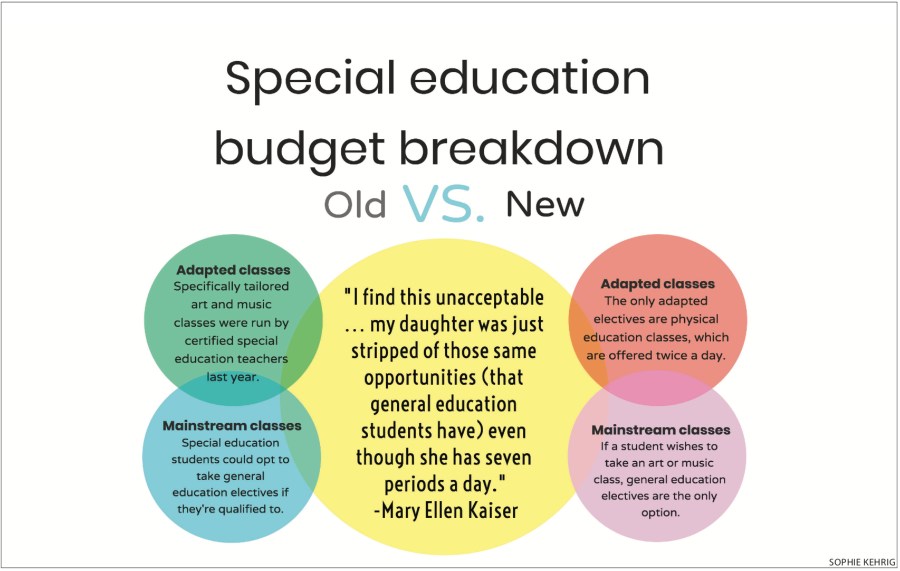District discontinues special education adapted art, music classes
Parent Mary Ellen Kaiser was shocked when she was informed the first day of school that the adapted art and music classes her daughter took last year would be cut from the master schedule.
These are classes for special education students taught by elective-specific teachers. But this year, they would be replaced with an adapted physical education class twice a day. According to parent Joan Mason, the change was made last spring by the School Board as part of the budget cuts.
“I find this unacceptable … my daughter was just stripped of those same opportunities (that general education students have) even though she has seven periods a day,” Kaiser said at the Sept. 11 School Board meeting. “I’m here fighting not only for her, but for all special ed students coming up in the system. Parents with special ed first graders should be concerned about special ed services being cut in order to balance the budget.”
At the end of the last school year, Mason met with director of student services Stefanie Hayes to discuss the decision. According to Mason, Hayes indicated that there would be new, certified special education teachers hired through Wayne County RESA. The organization provides services and support to school districts in Wayne County as well as money to oversee ACT 18 Programs or Special Education Programs for Handicapped Children.
In other words, the district taps into funds available through Wayne County RESA but does all of its own hiring for teachers and paraprofessionals for adapted art, music and P.E. classes.
According to Superintendent Gary Niehaus, teachers have to be highly qualified in both special education and certain elective areas like P.E. to be eligible for ACT 18 funding. The adaptive art and music teachers were highly qualified in special education but not in art and music. Co-teaching art and music classes makes funding available.
He added that 2.8 teachers were added to the ACT 18 reimbursement for the 2017-18 school year.
At the Sept. 11 meeting, parents Karen Grobbel and Kaiser said that they weren’t informed about the change at their last Individualized Education Program meeting in June, which outlines the special education students’ personalized curriculum. The unanticipated announcement that adapted classes will no longer be in the master schedule angered Mason, Grobbel and Kaiser.
Niehaus agreed that communicating the change was a challenge and that the district could do better.
Although the change comes as a surprise to some parents, Hayes said she has seen integrated general education classes work well in the past.
“Our kids are awesome. The general education students that support and work with our kids in those programs and classes tend to all benefit from being part of it,” Hayes said. “(This) shows our commitment to having our students included with all students in each building.”
If special education students opt to take an art and/or music class, they must join general education students in a non-adapted class. This change mainly affects special education students with cognitive impairments, as some students with autism spectrum disorder have already taken classes with general education students.
Special education students still have access to the same electives as general education students, Hayes said. However, enrolling in general education classes requires a long process of scheduling. In addition, many students need a paraprofessional to go with them, which makes scheduling even more difficult. Mason said that the special education department began working harder to accommodate special education students’ needs after the discussion at the meeting.
Also, many parents are concerned that general education classes won’t meet their children’s needs, as these classes aren’t adapted to special education students and can eventually lose meaning to them.
“There are a lot of special ed kids for whom the placements are official. Their parents want them in there, and that is great, and I am for whatever works for the student. But, the curriculum in the high school music or choir classrooms are designed to be competitive, performance-based, and they are not singing music that is going to make sense to someone with a significant disability,” Mason said. “The chances of the experience in a general education classroom at the high school level for a lot of these particular students being of benefit to them is small.”
Special education teacher Ellen Nichols prefers to give her students the opportunity to learn with general education kids. She said it helps them work on their social skills.
“Some of my students go to an art class second hour, and it’s a (general education) art class, and I kind of prefer it that way because then my students get to get out of this classroom, and they get to be in the (general education) setting, which doesn’t really happen that often. So they get to be around other kids that don’t have special needs. I think that benefits everybody,” Nichols said. “There is a lot of modeling that goes on that they get to see, and they get to see new faces and meet new kids that they haven’t met before.”
Nichols added that even though art and music classes aren’t officially part of a special education student’s schedule anymore, the additional P.E. class time is beneficial. She has noticed that her students enjoy the physical activity and understands that teaching them about nutrition and lifestyle is important as well.
Although general education classes aren’t for the right fit for all special education students, Hayes said she wants to continue to accommodate those interested that meet requirements to learn in those classes.
“I just know that it’s a concern area that we want to make sure that we’re doing right by all of our kids,” she said. “We’re going to do the best we can to make every kid have access to their curriculum, to their peers and to the electives.”


